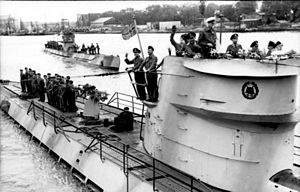| German submarine U-104 (1940) | |
|---|---|
| Career | |
| Name: | U-104 |
| Ordered: | 24 May 1938[1] |
| Builder: | AG Weser, Bremen |
| Yard number: | 967[1] |
| Laid down: | 10 November 1939[1] |
| Launched: | 25 May 1940[1] |
| Commissioned: | 19 August 1940[1] |
| Fate: | Missing since 28 November 1940 northwest of Ireland. All 49 of her crew are presumed lost[2] |
| General characteristics [3][4] | |
| Displacement: |
1,051 t (1,034 long tons) surfaced 1,178 t (1,159 long tons) submerged |
| Length: |
76.5 m (251 ft 0 in) overall 58.7 m (192 ft 7 in) pressure hull |
| Beam: |
6.8 m (22 ft 4 in) overall 4.4 m (14 ft 5 in) pressure hull |
| Height: | 9.6 m (31 ft 6 in) |
| Draft: | 4.7 m (15 ft 5 in) |
| Speed: |
33.9 kilometres per hour (18.3 kn) surfaced 13.5 kilometres per hour (7.3 kn) submerged |
| Range: |
41,000 km (22,000 nmi) at 19 kilometres per hour (10 kn) surfaced 219 km (118 nmi) at 7.4 km/h (4.0 kn) submerged |
| Service record[2][5] | |
|---|---|
| Part of: |
2nd U-boat Flotilla (19 August 1940–31 October 1940) 2nd U-boat Flotilla (1 November 1940–28 November 1940) |
| Commanders: |
Kapitänleutnant Harald Jürst (19 August 1940–28 November 1940) |
German submarine U-104 was a Type IXB U-boat of the Nazi German Kriegsmarine during World War II. She was ordered by the Kriegsmarine on 24 May 1938 as part of the German naval rearmament program Plan Z. Her keel was laid down by AG Weser in Bremen in November 1939. Following about six and a half months of construction, she was launched in May 1940 and formally commissioned into the Kriegsmarine in August 1940.
U-104 had a very short career, sinking just one enemy vessel and damaging one other during one war patrol. In the middle of her first patrol, U-104 was posted missing off the north coast of Ireland on 28 November 1940 and was presumed sunk in minefield SN 44, which was laid a few days prior to her arrival in the area.
Construction and design[]
Construction[]
U-104 was ordered by the German Kriegsmarine on 24 May 1938 (as part of Plan Z and in violation of the Treaty of Versailles). Her keel was laid down on 10 November 1939 by AG Weser in Bremen as Werk 967. U-104 was launched on 25 May 1940 and commissioned on 19 August of that year under the command of Kapitänleutnant Harald Jürst.[2]
Design[]

U-123–an identical U-boat to U-104–leaving Lorient on 8 June 1941
Like all Type IXB submarines, U-104 had a total output of 1,000 hp (746 kW) while submerged and 4,400 hp (3,281 kW) when surfaced. As a result, she could travel at a maximum speed of 33.9 kilometres per hour (18.3 kn) while surfaced and 13.5 kilometres per hour (7.3 kn) while submerged. U-104 had a range of 41,000 km (22,000 nmi) at 19 kilometres per hour (10 kn) while on the surface and 219 km (118 nmi) at 7.4 km (4.0 nmi) while submerged. She was equipped with six torpedo tubes (four in the bow, two in the stern) and carried a total of 22 533 mm (21 in) torpedoes. The submarine could also be equipped with 44 TMA mines instead of torpedoes. U-104's main deck gun was a Utof 10.5 cm SK C/32 naval gun[6] with 110 rounds. U-104 also carried the standard 2 cm FlaK 30 anti-aircraft gun. She had a crew of 49 men, but could carry up to 56 crew members at any given time. After being commissioned and deployed, U-104 was stationed in the German port city of Wilhelmshaven.[3][4]
Service history[]
During her short career, U-104 sank one enemy vessel and damaged another on her first and only war patrol in the North Sea, off the northern coast of Ireland and Great Britain.[2] She went to sea on her first and only war patrol on 12 November 1940. For a period of 17 days, she roamed the North Sea and eventually the northern coast of Scotland and Ireland in search of any Allied convoys heading to Great Britain. During that time she attacked two enemy vessels, sinking one and damaging the other.[7] On 27 November 1940, U-104 torpedoed and sank the British merchant vessel Diplomat with the loss of 14 of her crew.[8] The other merchant vessel was the British motor tanker Charles F. Meyer, which survived the attack. The next day, U-104 went missing just north of neutral Ireland. She is presumed to have been sunk by a mine from the SN 44 minefield, which was laid on 8 November 1940, just 20 days prior to U-104's disappearance.[7] All of her crew are presumed dead.[2]
References[]
- ↑ 1.0 1.1 1.2 1.3 1.4 "U-104 Type IXB". ubootwaffe.net. http://ubootwaffe.net/ops/boat.cgi?boat=104. Retrieved 8 June 2010.
- ↑ 2.0 2.1 2.2 2.3 2.4 Helgason, Guðmundur. "U-104". German U-boats of WWII. Uboat.net. http://www.uboat.net/boats/u104.htm. Retrieved 8 June 2010.
- ↑ 3.0 3.1 Helgason, Guðmundur. "Type IXB". U-Boat War in World War II. Uboat.net. http://www.uboat.net/types/ixb.htm. Retrieved 8 June 2010.
- ↑ 4.0 4.1 "Type IX U-Boat". German U-boat. Uboataces.com. http://www.uboataces.com/uboat-type-ix.shtml. Retrieved 8 June 2010.
- ↑ Helgason, Guðmundur. "War Patrols by U-104". U-boat patrols. Uboat.net. http://www.uboat.net/boats/patrols/u104.html. Retrieved 8 June 2010.
- ↑ Campbell, John Naval Weapons of World War Two ISBN 0-87021-459-4 pp.248&249
- ↑ 7.0 7.1 Helgason, Guðmundur. "Patrol info for U-104 (First patrol)". U-boat patrols. Uboat.net. http://www.uboat.net/boats/patrols/patrol_3703.html. Retrieved 8 June 2010.
- ↑ Helgason, Guðmundur. "Diplomat (Steam merchant)". Ships hit by U-boats. Uboat.net. http://www.uboat.net/allies/merchants/ships/677.html. Retrieved 8 June 2010.
External links[]
- U-104 at u-boot-archiv.de (German)
See also[]
Coordinates: 55°30′N 8°0′W / 55.5°N 8°W
The original article can be found at German submarine U-104 (1940) and the edit history here.